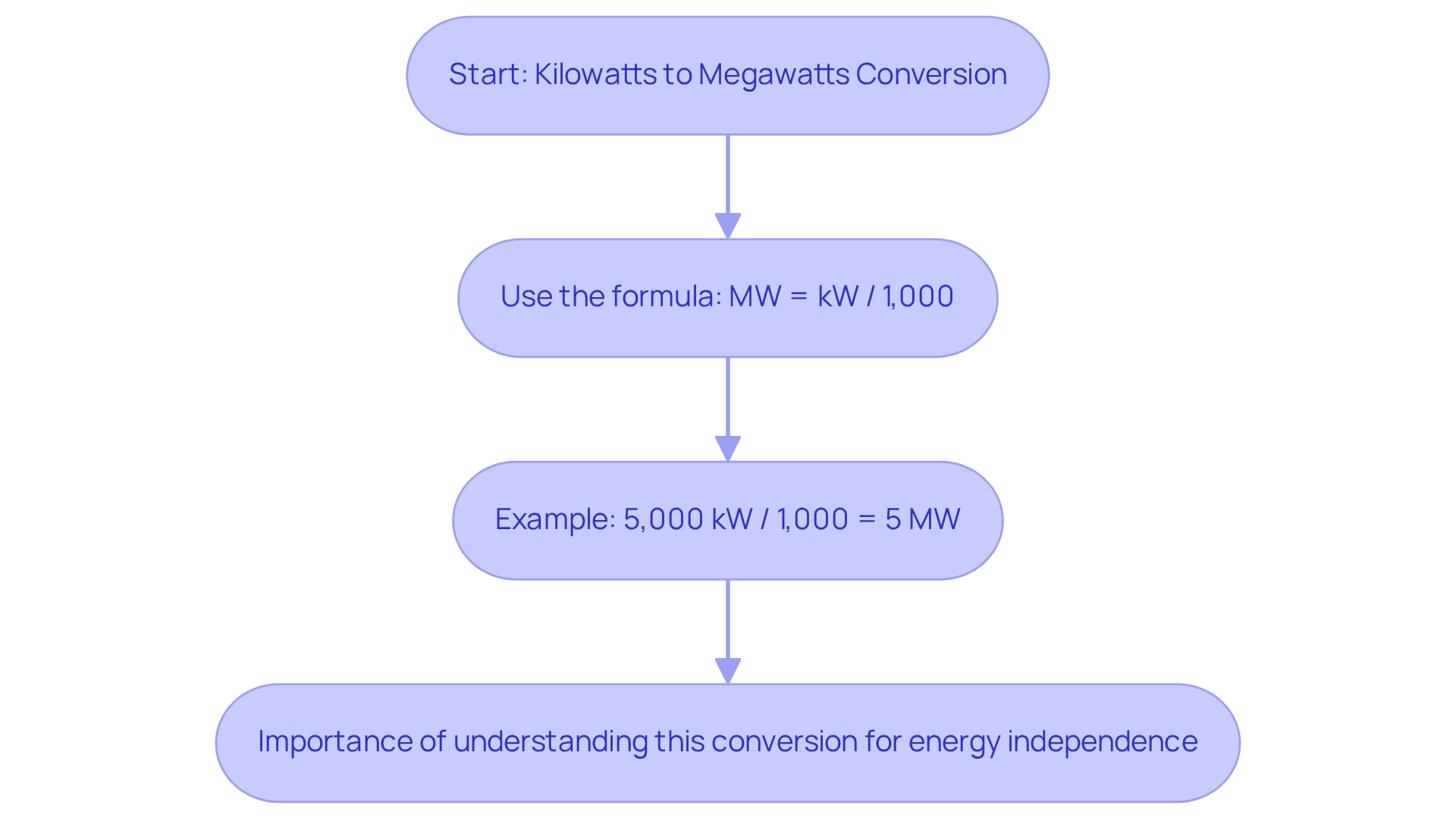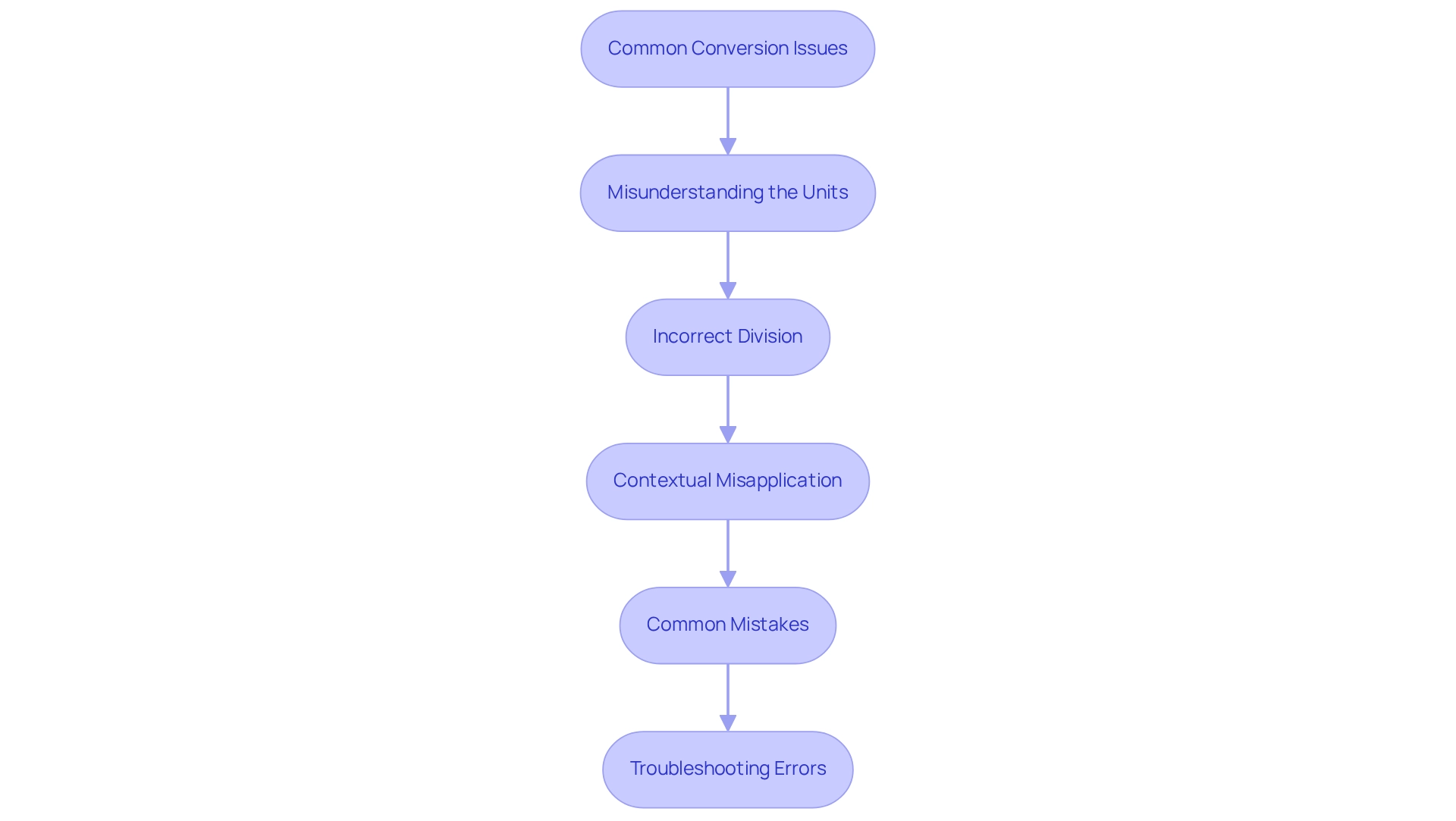Overview
We understand that managing energy bills can be a significant concern for homeowners. The article provides a comprehensive guide on converting kilowatts to megawatts, emphasizing the formula MW = kW / 1,000 for accurate conversions.
By illustrating practical examples of various energy systems, it highlights the importance of understanding these conversions for evaluating energy needs. This knowledge is crucial as it empowers you to maximize the benefits of renewable energy sources like solar power.
Together, we can explore how these conversions not only help in managing costs but also pave the way towards energy independence. Let’s work towards a sustainable future where your energy choices reflect your values and needs.
Introduction
In a world increasingly powered by renewable energy, we understand that many homeowners are concerned about rising energy bills and are exploring sustainable solutions. Understanding the fundamentals of power measurement is essential for those considering solar energy systems. Kilowatts (kW) and megawatts (MW) are not just technical jargon; they are vital units that define energy production and consumption.
As you explore the potential benefits of solar installations, grasping the difference between these units can lead to significant savings and a deeper appreciation of energy efficiency. This article delves into the nuances of kilowatts and megawatts, offering practical insights into conversions, common pitfalls, and real-world applications that empower you to make informed energy decisions.
Whether evaluating the capacity of a residential solar panel or understanding the scale of a commercial installation, the knowledge gained here is crucial for navigating the evolving landscape of solar energy. Together, we can embrace the journey towards energy independence and sustainability.
Understand Kilowatts and Megawatts
The conversion from kilowatts to megawatts is vital in understanding power measurement units that can significantly impact your energy bills. A kilowatt equals 1,000 watts, and in converting kilowatts to megawatts, a megawatt represents . For homeowners exploring photovoltaic setups, understanding these units is crucial, as power output is often expressed in these terms. Have you considered that a typical home photovoltaic panel arrangement generates between 5 kW and 10 kW? In contrast, larger energy farms can produce several megawatts of power, showcasing the potential of solar energy.
Grasping the generation of kilowatts to megawatts is essential for evaluating your power needs and the capabilities of photovoltaic installations. In California, the expected residential photovoltaic system in 2025 is projected to generate about 6 kW. This could lead to substantial savings on your utility costs—around $1,500 each year—which can enhance your home value by up to $30,000. Imagine the peace of mind that comes with knowing your investment is not only beneficial for the environment but also for your wallet.
While it’s common to feel concerned about energy generation on overcast days, battery systems play a crucial role in compensating for this decreased output. They ensure that you maintain power reliability, allowing you to feel secure in your energy choices. This knowledge empowers you to make informed decisions regarding your power usage and the advantages of renewable technology. Together, we can explore how these solutions can work for you, enhancing both your lifestyle and the planet.
Apply the Conversion Formula
We understand that navigating energy bills can be overwhelming. To help you make sense of , let’s explore the process of [converting kilowatts to megawatts](https://gopowercoreinc.com/solar-battery-storage-insights/convert-kw-to-megawatt-simple-steps-for-homeowners/). The formula is simple: MW = [[[kW / 1,000](https://gopowercoreinc.com/solar-battery-storage-insights/understanding-kilowatt-in-megawatt-essential-energy-concepts/)](https://gopowercoreinc.com/solar-battery-storage-insights/understanding-kilowatt-in-megawatt-essential-energy-concepts/)](https://gopowercoreinc.com/solar-battery-storage-insights/understanding-kilowatt-in-megawatt-essential-energy-concepts/). This means that you can easily convert kilowatts to megawatts by dividing the number of kilowatts by 1,000. For instance, if you have a solar system that produces 5,000 kilowatts to megawatts, the conversion from kilowatts to megawatts would be: [[[[[5,000 kW / 1,000](https://ecowatch.com](https://gopowercoreinc.com/solar-battery-storage-insights/master-kilowatt-megawatt-conversion-with-these-simple-steps/)/solar/what-is-a-mega-watt)](https://ecowatch.com/solar/what-is-a-mega-watt) = 5 MW](https://gopowercoreinc.com/solar-battery-storage-insights/understanding-kilowatt-in-megawatt-essential-energy-concepts/)](https://gopowercoreinc.com/solar-battery-storage-insights/understanding-kilowatt-in-megawatt-essential-energy-concepts/).
Understanding this conversion is essential, especially when considering the potential of solar energy. It’s common to feel uncertain about the scale of energy production, particularly when comparing residential systems to . However, embracing solar energy not only helps in reducing your energy bills but also brings you closer to energy independence. Together, we can explore how solar solutions can empower you and your home. If you have any questions or need guidance, please reach out. We’re here to support you on this journey.
Explore Practical Conversion Examples
For homeowners concerned about rising energy bills, understanding how to convert kilowatts to megawatts is vital in maximizing the benefits of solar energy. Here are several practical examples that can help illuminate this concept:
-
Example 1: A residential solar panel system rated at 8 kW:
- Conversion: 8 kW / 1,000 = 0.008 MW
-
Example 2: A commercial solar installation rated at 150 kW:
- Conversion: 150 kW / 1,000 = 0.15 MW
-
Example 3: A large solar farm rated at 2,500 kW:
- Conversion: 2,500 kW / 1,000 = 2.5 MW
These examples illustrate the straightforward application of the conversion formula across different contexts, enabling you to grasp the scale of energy production in various settings. Understanding these conversions is essential, especially since many incentives and rebates rely on the scale of your energy installation. For instance, the average power generation of home photovoltaic systems typically varies from 5 to 10 kilowatts to megawatts, which equates to 0.005 to 0.01 MW. This knowledge can significantly influence your savings and efficiency.
Moreover, selecting the right battery for renewable energy is crucial for homeowners. The FranklinWH aPower 2 battery, with a capacity of up to 15 kWh per unit, exemplifies the importance of in maximizing your solar investments. Additionally, the case study titled ‘How Homeowners Benefited from Household Solar Systems Under the 200% Rule’ underscores the necessity of making these calculations accessible for consumers, helping you understand your energy needs. Together, we can navigate these options and empower you toward a more sustainable future.
Troubleshoot Common Conversion Issues
When converting kilowatts to megawatts, we understand that several common issues can hinder accuracy, and we want to help you navigate them:
- Misunderstanding the Units: It’s essential to grasp the distinction between kilowatts (kW) and megawatts (MW). Specifically, the indicates that 1 MW is equivalent to one thousand kW, which is crucial for precise conversions.
- Incorrect Division: Always verify your calculations to ensure you are dividing by 1,000. A small miscalculation can lead to significant mistakes in power evaluations, affecting your choices regarding renewable power solutions.
- Contextual Misapplication: Consider the context in which these conversions are applied. For instance, when analyzing power generation from a photovoltaic panel system, it’s vital to assess its output over time, not merely as a fixed number.
- Common Mistakes: One prevalent mistake is failing to account for the scale of power production. For example, converting kilowatts to megawatts, a 500 kW photovoltaic installation produces 0.5 MW of power, which is a more relevant unit for large-scale power generation.
- Troubleshooting Errors: If you encounter discrepancies in your calculations, revisit your initial data and ensure that all figures are correctly interpreted. For example, if your renewable energy home needs a battery system, understanding the average daily usage is essential. A suggested battery capacity of approximately 11 kWh can ensure essential loads are powered during peak periods or outages, enhancing power reliability.
By being vigilant about these common issues, together we can achieve accurate conversions and gain a clearer understanding of your energy needs. This ultimately leads to more informed decisions regarding solar energy solutions, fostering a sense of empowerment and independence in your energy journey.
Conclusion
We understand that many homeowners are concerned about rising energy bills and the impact on their budgets. Understanding the distinctions between kilowatts and megawatts is vital for those contemplating solar energy systems. These units not only represent the scale of energy production but also play a significant role in evaluating energy savings and system efficiency. By grasping these concepts, you can make informed decisions that enhance your energy independence and contribute to sustainable living.
Utilizing the conversion formula between kilowatts and megawatts is essential for accurately assessing the capacity of solar installations, whether residential or commercial. Practical examples illustrate how these conversions apply in real-world scenarios, empowering you to maximize the benefits of solar energy. Additionally, being aware of common pitfalls in conversion processes can prevent costly errors and improve overall energy management strategies.
In conclusion, the journey towards harnessing solar energy begins with understanding the fundamentals of power measurement. By equipping yourself with knowledge about kilowatts and megawatts, you can confidently navigate the solar energy landscape. Together, let’s ensure you make choices that lead to substantial energy savings and a reduced carbon footprint. Embracing these insights paves the way for a more sustainable and economically sound future. Remember, we are here to support you every step of the way.





